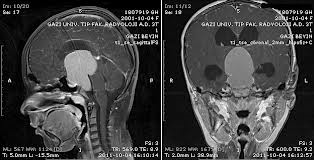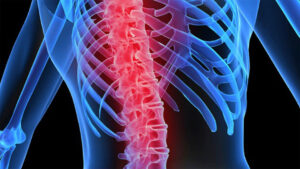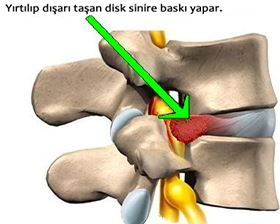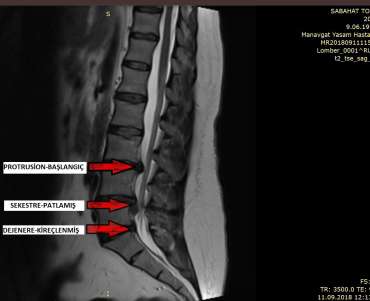
Herniated Disc

Herniated Disc
What is a Herniated Disc?
It occurs when the cartilage between the vertebrae in our lumbar region tears, compressing the nerves exiting the spinal cord. It first manifests as severe back pain, then pain radiating to the legs.
Surgical interventions for patients whose pain persists despite bed rest and some painkillers, whose social lives are affected, and who develop ambulatory paralysis are rapidly improving today, allowing patients to quickly return to their former lives. In cases where treatment is delayed, the pain and paralysis can become permanent.
Waist Anatomy
There are three natural curves in the spine: neck, back and waist.
- Thanks to these curvatures, our spine minimizes the amount of load on it and can move flexibly.
- The lumbar region consists of 5 vertebrae and the sacrum bone.
- The vertebrae overlap each other to form the spinal canal through which the spinal cord and nerves pass.
- The spine protects the spinal cord and nerves; enables our body to move.
- The vertebrae are held together by cushions called "discs" at the front and "facet" joints at the back.
- Discs are actually jelly-like shock absorbers that prevent the vertebrae from rubbing against each other.
The function of the discs is to absorb the shocks that occur during walking, sitting and lifting, and to transfer the weight to the lower levels in a balanced manner by reducing the load on the vertebrae equally.
The vertebrae are attached to each other from behind by two facet joints.
Each disc consists of two parts: an outer layer, woven with strong fibers, and a soft, jelly-like inner layer. The tough outer layer protects the soft, jelly-like inner layer and allows for flexible movement. In addition to these structures, the spine is supported by ligaments and muscles. Ligaments are strong bands that hold the discs and vertebrae in place. Muscles control movement, support the spine, and provide stability.
The spinal cord is responsible for transmitting commands from our brain to the rest of our body. The spinal cord terminates in the upper lumbar region and gives off nerve branches to the leg muscles, bladder, and genitals. These nerves provide movement and sensation in the legs, urination, defecation, and sexual function.
How Does a Herniated Disc Occur?
In addition to many external factors, such as lifting a heavy load or performing an awkward movement, personal factors also play a significant role in the development of a herniated disc. Some people lift 120 kg and experience no discomfort, while others lift only 5 kg and develop a herniated disc.
One of the primary factors affecting the individual is degeneration of the cartilage between the vertebrae, known as the disc. Just as nothing in the universe is left to chance, the disc's nutrition follows a specific plan and schedule. Certain substances pass through specific areas of the disc. However, with age, the number of vessels supplying the disc diminishes and disappears completely after the age of approximately eight. After this age, the disc's nutrition is achieved through diffusion.
The water content of discs begins to gradually decrease from childhood onward. While the water content in a fetal disc is 90 %, this decreases to 80 % in children and 50-60 % in adults. Consequently, the disc gradually shrinks and decreases in height.
This is accompanied by nutritional deficiencies, microscopic changes, chemical changes, and degeneration caused by mechanical forces applied to the disc. The amount of oxygen and nutrients entering the disc gradually decreases, making it harder to eliminate metabolic waste products. Over time, the disc loses its elasticity and can no longer transmit force and distribute it evenly to surrounding tissues.
The number of supporting cells within the disc, which perform repair functions, also decreases with age. Repair becomes less effective. When excessive pressure is placed on micro-cracks or when a person makes a mistake, the soft inner part of the disc can easily tear the surrounding capsule and protrude, resulting in a herniated disc. So, once the groundwork is ready, a final straw is needed, which could be lifting a light object or simply coughing.
Which Patients Should Undergo Surgery?
If a patient continues to struggle with conservative, nonsurgical treatment, but continues to experience persistent pain that naturally diminishes their quality of life, they are considered candidates for surgery. There's no need for them or their loved ones to endure constant suffering.
Some patients recover with conservative treatment, but their condition relapses after a while. Sometimes they are better, sometimes worse. Some people experience this condition for years. With each relapse, their work, family, and social lives are severely affected, virtually disrupted. These patients are often very afraid of surgery. Surgery is often considered for those whose herniated discs recur frequently, and whose productivity and quality of work are significantly reduced, disrupting their normal routine for weeks at a time. The cause of their discomfort should be explained in detail to these patients, and the decision to undergo surgery should be left to them.
Some patients experience back and leg pain along with numbness, weakness, and weakening and thinning of the leg muscles. These conditions are constantly deteriorating. These conditions should not be allowed to worsen, and the necessity of surgery should be explained to them.
Emergency Surgery Situations
If a patient with a herniated disc experiences symptoms such as inability to urinate or defecate, numbness around the anus and genitals, or paralysis in the legs, they must undergo emergency surgery. Hours, even minutes, are crucial in such a patient. Even in the middle of the night, surgery must be performed immediately to relieve pressure on the nerves.
The idea that a herniated disc will heal on its own if you wait doesn't apply to every patient. Our long-standing experience has shown that successful surgery shortens the recovery period, and patients generally return to work sooner.


